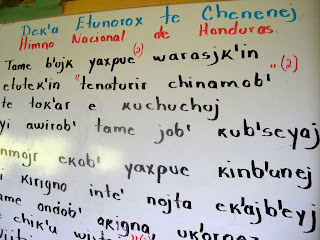 From inside the school at Buena Vista. The Honduran National Anthem, translated into Chorti, language of the ancient Maya.
From inside the school at Buena Vista. The Honduran National Anthem, translated into Chorti, language of the ancient Maya. Buena Vista and neighboring villages are working to reclaim Chorti, their ancestral language. There aren't any living speakers, at least not around here. A few times a week, a teacher comes in from Copan and gives a lesson.
At a meeting inside the school, Jose Manuel asked one of the young girls to stand up and read some Chorti from a chart on the wall. First she read the Spanish, then the Chorti translation. Hello, good day, how are you, mother, father. Language recovery in progress.























